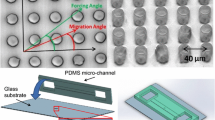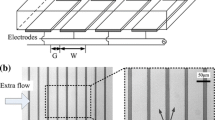Abstract
This work presents a novel method for continuous particle separation on the microscale by means of field-flow fractionation. It is based on the use of asymmetric interdigitated electrode arrays on the channel bottom, which induce an electro-osmotic channel flow when driven harmonically. Suspended particles are influenced by viscous fluid drag, sedimentation as well as by dielectrophoretic repulsion forces from the driving electrodes due to the emerging electric field. The significant dependance of the present forces on particle properties allows for separation with respect to particle density and size. This work analyzes electric and flow field by means of the finite element method and investigates the size and density dependent particle motion as a function of driving voltage and frequency of the electrode array. Matching these driving parameters permits the separation of sedimenting particles by their density independently from their size as well as the separation by size. Finally, channel designs are proposed which enable standard separation by means of selective particle mobility in the channel, separation in terms of opposing motion directions, as well as continuous lateral separation.
















Similar content being viewed by others
References
Ajdari A (2000) Pumping liquids using asymmetric electrode arrays. Phys Rev E 61(1):R45–R48
Aldaeus F, Lin Y, Amberg G, Roeraade J (2006) Multi-step dielectrophoresis for separation of particles. J Chrom A 1131(1–2):261–266
Castellanos A, Ramos A, González A, Green NG, Morgan H (2003) Electrohydrodynamics and dielectrophoresis in microsystems: scaling laws. J Phys D Appl Phys 36(20):2584–2597
Fan LS, Zhu C (1998) Principles of gas–solid flows. Cambridge University Press, London
Green NG, Morgan H, Milner JJ (1997) Manipulation and trapping of sub-micron bioparticles using dielectrophoresis. J Biochem Biophys Meth 35(2):89–102
Green NG, Ramos A, González A, Morgan H, Castellanos A (2002) Fluid flow induced by nonuniform AC electric fields in electrolytes on microelectrodes. III. Observation of streamlines and numerical simulation. Phys Rev E 66(2):026305
Hilber W, Weiss B, Mikolasek M, Holly R, Hingerl K, Jakoby B (2008) Particle manipulation using 3D AC electro-osmotic micropumps. J Micromech Microeng 18:6
Huang Y, Wang XB, Becker FF, Gascoyne PR (1997) Introducing dielectrophoresis as a new force field for field-flow fractionation. Biophys J 73(2):1118–1129
Huh D, Bahng J, Ling Y, Wei HH, Kripfgans OD, Fowlkes JB, Grotberg JB, Takayama S (2007) Gravity-driven microfluidic particle sorting device with hydrodynamic separation amplification. Anal Chem 79(4):1369–1376
Kilic MS, Bazant MZ, Ajdari A (2007a) Steric effects in the dynamics of electrolytes at large applied voltages. I. Double-layer charging. Phys Rev E 75(2):021502
Kilic MS, Bazant MZ, Ajdari A (2007b) Steric effects in the dynamics of electrolytes at large applied voltages. II. Modified Poisson–Nernst–Planck equations. Phys Rev E 75(2):021503
Minerick AR, Zhou R, Takhistov P, Chang HC (2003) Manipulation and characterization of red blood cells with alternating current fields in microdevices. Electrophoresis 24:3703–3717
Morgan H, Hughes M, Green N (1999) Separation of submicron bioparticles by dielectrophoresis. Biophys J 77(1):516–525
Myers MN (1997) Overview of field-flow fractionation, chap 9. Wiley, NewYork, pp 151–162
Olesen LH, Bruus H, Ajdari A (2006) AC electrokinetic micropumps: the effect of geometrical confinement, faradaic current injection, and nonlinear surface capacitance. Phys Rev E 73(5):056313
Petersson F, Aberg L, Sward-Nilsson AM, Laurell T (2007) Free flow acoustophoresis: microfluidic-based mode of particle and cell separation. Anal Chem 79(14):5117–5123
Pohl HA (1978) Dielectrophoresis. Cambridge University Press, London
Radko Sergey PCA (1999) Capillary electrophoresis of subcellular-sized particles. J Chrom B 722(1–2):1–10
Ramos A, González A, Castellanos A, Green NG, Morgan H (2003) Pumping of liquids with AC voltages applied to asymmetric pairs of microelectrodes. Phys Rev E 67(5):056302
Tuval I, Mezić I, Bottausci F, Zhang YT, MacDonald NC, Piro O (2005) Control of particles in microelectrode devices. Phys Rev Lett 95(23):236002
Urbanski JP, Levitan JA, Burch DN, Thorsen T, Bazant MZ (2007) The effect of step height on the performance of three-dimensional AC electro-osmotic microfluidic pumps. J Coll Interf Sci 309(2):332–341
Vastamäki P, Jussila M, Riekkola ML (2005) Continuous two-dimensional field-flow fractionation: a novel technique for continuous separation and collection of macromolecules and particles. Analyst 130:427–432
Velev OD, Bhatt KH (2006) On-chip micromanipulation and assembly of colloidal particles by electric fields. Soft Matter 2:738–750
Wang XB, Vykoukal J, Becker FF, Gascoyne PR (1998) Separation of polystyrene microbeads using dielectrophoretic/gravitational field-flow-fractionation. Biophys J 74(5):2689–2701
Weiss B, Hilber W, Holly R, Gittler P, Jakoby B, Hingerl K (2008) Dielectrophoretic particle dynamics in alternating-current electro-osmotic micropumps. Appl Phys Lett 92(18):184101
Zhang Y, Barber RW, Emerson DR (2005) Particle separation in microfluidic devices—splitt fractionation and microfluidics. Curr Anal Chem 1(3):345–354
Author information
Authors and Affiliations
Corresponding author
Rights and permissions
About this article
Cite this article
Weiss, B., Hilber, W., Gittler, P. et al. Particle separation in alternating-current electro-osmotic micropumps using field-flow fractionation. Microfluid Nanofluid 7, 191–203 (2009). https://doi.org/10.1007/s10404-008-0374-5
Received:
Accepted:
Published:
Issue Date:
DOI: https://doi.org/10.1007/s10404-008-0374-5




